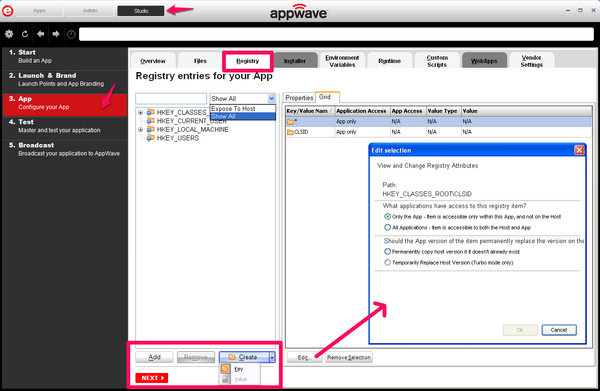Configure your App:Registry Settings
Go Up to Configure you App
In the registry entries for your app you can:
- Add a registry key from the system registry.
- Remove a registry key you have added.
- Create a registry key or value.
When modifying registry keys it is important to know the system variables. You need to know what variables can be used that will be replaced with the correct path when an app is loaded on a machine.
For more information, see: Predefined Virtual Folders
On the left is a tree of registry setting groups. The base folders are defined in the .tca model:
HKEY_CLASSES_ROOTHKEY_CURRENT_USERHKEY_LOCAL_MACHINEHKEY_USERS
You have a drop-down box where you can select the Show All (visible only to the App) or Exposed To Host (visible on the host machine).
Warning: It is best practice to review the registry settings before broadcasting your application. Make sure there are no files or registry keys not directly relating to the application. Remove any that have been included in error. You need to also verify that registry keys refer to a generic path. For example a path should be %USERPROFILES%\Documents not C:\Documents and Settings\<username>\Documents.
View and Change Attributes
In the right-hand panel you can view and/or change the attributes of a selected registry entry.
Edit selection options:
| Command | Description |
|---|---|
| What applications have access to this registry | |
| Only the App | These are items accessible only within the App, and not on the Host. The selected file or folder is only accessible within the app and is not visible to the host machine.
Files or folders with attribute changes are kept private in a cache managed by the Browser. |
| All Applications | The selected file or folder is available to the host and app, and can be accessed by external processes and users.
Unless it is hidden from the folder listings, it is displayed by any and all applications that list the contents of the host machine’s file system. |
| Should the app version of the item permanently replace the version on the Host? | |
| Permanently copy host version if it doesn’t already exist | Before activation, the app checks to see if this registry already exists on the host machine. If it does, it uses the existing file.
If the file does not exist, it is permanently placed on the machine. Note: See caution below when mastering an app on the Windows 7 OS. |
| Temporarily Replace Host Version (Turbo mode only) | If this registry already exists on the host machine, the app version of the file replaces the existing file as long as the app is active in the Browser.
If you remove the app or clear the local Browser cache, the previous version is restored. |
Warning: When mastering an app on the Windows 7 OS, create registry keys under HKEY_CLASSES_ROOT or in one of the subdirectories of HKEY_CURRENT_USER, HKEY_LOCAL_MACHINE, and HKEY_USERS.
If the properties for the key you created are set to All Applications, Permanently Copy Host Version and Temporarily Replace Host Version an error message (APM_E_APP_CONFIG_INSTALL_REGISTRY) will be generated.To fix this registry problem, you must delete the key you just created.
